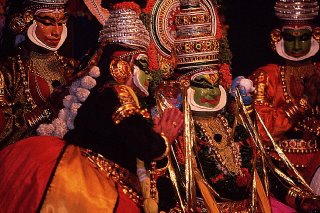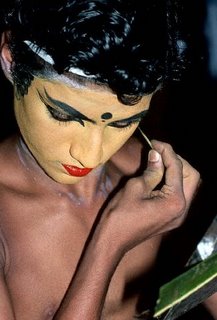
Kathakali is a form of Indian dance-drama. It originated in the Indian state of Kerala during the 7th century C.E. The Raja of Kottarakara is the earliest exponent of this art. It is considered to be one of the oldest dance forms in India. It is a spectacular combination of drama, dance, music and ritual. Characters with vividly painted faces and elaborate costumes re-enact stories from the Hindu epics, Mahabharatha and Ramayana.
Kathakali explicates events and stories from the Indian Epics and 'Puranas', ancient scriptures. Presented in the temple precincts after dusk falls, Kathakali is heralded by the Kelikottu or the beating of drums in accompaniment of the Chengila (gong).
The dancers adorn themselves with huge skirts and head-dress, wearing a most intricate style of make-up. The richness of this riveting mix of colour, expression, music, drama and dance is unparalleled in any other art form.

In olden days Kathakali performance mostly took place on a temple premises or at the house of a local land lord. A pandal or a canopy with a thatched roof would be erected with a green room located close by. The stage is not raised, but at the same level as the audience and is decorated with coconut leaves, bunches of areca nuts etc. The only source of light is a big bell metal lamp placed down the center stage.
At about 6 o'clock in the evening the performance is announced by a brief passage of drumming known as Kelikottu. The actual performance begins only between 9 and 10 o'clock at night. Arrangukeli, another passage of drumming, marks the commencement of the performance. This is followed by Thodayam, a piece of abstract dance, which is invocatory in nature. Junior actors in the group with simple make-up perform Thodayam. The recitation of Vandanaslokam (a chanted prayer), is followed by Purappad, a preliminary item that introduces the main character of the story in full costume and make-up. Next is the Melappadam, which is a musical piece where vocalists and the drummers are given the opportunity to show their skill without depending on the actors. Then the story or part of the stories proposed is enacted, which may go on till the wee hours. The end of the performance is marked by a piece of pure dance called Dhanasi.
The current flourishing of the form is largely due to the efforts of the poet Vallathol, one of the cultural revivalists of the Independence era. Like Bharatanatyam, Kathakali also needed a resurrection in the 1930s. The great poet Vallathol rediscovered Kathakali, establishing the Kerala Kalamandalam in 1932, which gave new life to this art form.
No comments:
Post a Comment